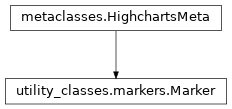.markers
class: Marker
- class Marker(**kwargs)[source]
Options for the point markers of line-like series.
Class Inheritance

- copy(other=None, overwrite=True, **kwargs)
Copy the configuration settings from this instance to the
otherinstance.- Parameters:
other (
HighchartsMeta) – The target instance to which the properties of this instance should be copied. IfNone, will create a new instance and populate it with properties copied fromself. Defaults toNone.overwrite (
bool) – ifTrue, properties inotherthat are already set will be overwritten by their counterparts inself. Defaults toTrue.kwargs – Additional keyword arguments. Some special descendents of
HighchartsMetamay have special implementations of this method which rely on additional keyword arguments.
- Returns:
A mutated version of
otherwith new property values
- classmethod from_dict(as_dict: dict, allow_snake_case: bool = True)
Construct an instance of the class from a
dictobject.
- classmethod from_js_literal(as_str_or_file, allow_snake_case: bool = True, _break_loop_on_failure: bool = False)
Return a Python object representation of a Highcharts JavaScript object literal.
- Parameters:
as_str_or_file (
str) – The JavaScript object literal, represented either as astror as a filename which contains the JS object literal.allow_snake_case (
bool) – IfTrue, interpretssnake_casekeys as equivalent tocamelCasekeys. Defaults toTrue._break_loop_on_failure (
bool) – IfTrue, will break any looping operations in the event of a failure. Otherwise, will attempt to repair the failure. Defaults toFalse.
- Returns:
A Python object representation of the Highcharts JavaScript object literal.
- Return type:
HighchartsMeta
- classmethod from_json(as_json_or_file, allow_snake_case: bool = True)
Construct an instance of the class from a JSON string.
- Parameters:
as_json_or_file – The JSON string for the object or the filename of a file that contains the JSON string.
allow_snake_case (
bool) – IfTrue, interpretssnake_casekeys as equivalent tocamelCasekeys. Defaults toTrue.
- Returns:
A Python objcet representation of
as_json.- Return type:
HighchartsMeta
- to_dict() dict
Generate a
dictrepresentation of the object compatible with the Highcharts JavaScript library.Note
The
dictrepresentation has a property structure and naming convention that is intentionally consistent with the Highcharts JavaScript library. This is not Pythonic, but it makes managing the interplay between the two languages much, much simpler.
- to_js_literal(filename=None, encoding='utf-8') str | None
Return the object represented as a
strcontaining the JavaScript object literal.
- to_json(filename=None, encoding='utf-8')
Generate a JSON string/byte string representation of the object compatible with the Highcharts JavaScript library.
Note
This method will either return a standard
stror abytesobject depending on the JSON serialization library you are using. For example, if your environment has orjson, the result will be abytesrepresentation of the string.- Parameters:
- Returns:
A JSON representation of the object compatible with the Highcharts library.
- Return type:
- static trim_dict(untrimmed: dict, to_json: bool = False) dict
Remove keys from
untrimmedwhose values areNoneand convert values that have.to_dict()methods.
- static trim_iterable(untrimmed, to_json=False)
Convert any
EnforcedNullTypevalues inuntrimmedto'null'.
- property enabled: bool | None
If
True, markers are enabled. IfFalse, markers are disabled. IfNone, markers are hidden when the data is dense and shown for more widespread data points.Defaults to
None
- property enabled_threshold: int | None
The threshold for how dense the point markers should be before they are hidden, assuming that
Marker.enabled()isNone. Defaults to2.The number indicates the horizontal distance between the two closest points in the series, as multiples of the
Marker.radius(). In other words, the default value of2means points are hidden if overlapping horizontally.
- property fill_color: str | Gradient | Pattern | None
The fill color or gradient for the marker. Defaults to
None, which causes the series’ or point’s color to be used.
- property height: int | float | Decimal | None
Explicitly set the height of an image marker. Defaults to
None.Warning
Only applies to image markers. When setting this property,
Marker.width()must also be set.- Return type:
numeric or
None
- property line_color: str | Gradient | Pattern | None
The line color or gradient for the marker’s outline. Defaults to
'#ffffff'.
- property line_width: int | float | Decimal | None
The line width (in pixels) applied to the marker’s border. Defaults to
0.- Returns:
The line width to apply to the marker’s border.
- Return type:
numeric or
None
- property radius: int | float | Decimal | None
The radius applied to the point marker. Defaults to
4.- Returns:
The radius to apply to the point marker.
- Return type:
numeric or
None
- property symbol: str | None
A predefined shape or symbol for the marker. Defaults to
None.When
None, the symbol is pulled from (JavaScript)options.symbols. Other possible values are:'circle''square''diamond''triangle''triangle-down'
Additionally, the URL to a graphic can be given using the form:
'url(graphic.png)'.Note
For an image marker to be applied to exported charts, its URL needs to be accessible by the export server.